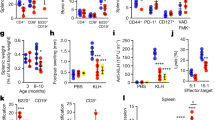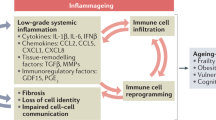Abstract
The loss of immune function which occurs with age has until recently been attributed to depletion of immunocompetent cells1–3. However, studies from our laboratory4–6 have indicated that the age-related decline in immune responsiveness is better explained by a qualitative rather than a quantitative defect at the level of both T cells and B cells. This conclusion was derived from experiments in which immune function was assessed in relation to the number of responding cells. Thus, lymphoid tissues from old and young mice were found to contain comparable numbers of T cells and B cells despite a 10-fold or greater difference in their antibody-forming potential and mitogenic activity. Furthermore, selective depletion of reactive sub-populations was excluded by the demonstration of similar proportions of mitogen and antigen-binding cells in lymphoid tissue from old and young mice. If the number of cells is normal in old animals, but their function is impaired, it is possible that the decline in immune competence with age may be due to a metabolic or structural abnormality, perhaps affecting the cell membrane and preventing the cell from responding normally to exogenous signals. We have therefore investigated whether any difference could be detected in membrane-associated antigens of lymphoid cells from old and young mice of the same strain. We report here that new or altered antigenic determinants seem to be expressed on the surface of lymphocytes from old mice. These might interfere with the normal immunological activities of such cells, and so perhaps explain their reduced immune competence.
This is a preview of subscription content, access via your institution
Access options
Subscribe to this journal
Receive 51 print issues and online access
$199.00 per year
only $3.90 per issue
Buy this article
- Purchase on Springer Link
- Instant access to full article PDF
Prices may be subject to local taxes which are calculated during checkout
Similar content being viewed by others
References
Burnet, F. M. Lancet ii, 358 (1970).
Albright, J. F. & Makinodan, T. J. cell. Physiol. 67, Suppl. 1, 185 (1966).
Kruisbeek, A. M. Mechanisms Ageing Dev. 5, 125 (1976).
Callard, R. E. & Basten, A. Cell. Immun. 31, 13 (1977).
Callard, R. E., Basten, A. & Waters, L. K. Cell. Immun. 31, 26 (1977).
Callard, R. E. & Basten, A. Eur. J. Immun. 8, 552 (1978).
Ben-Sasson, S. A. & Henkart, P. A. J. Immun. 119, 227 (1977).
Uhr, J. W. in Membrane Receptors of Lymphocytes (eds Seligmann, M., Preud'homme, J. L. & Kourilsky, F. M.) 3–12 (Masson, Paris, 1975).
Boyse, E. A., Old, L. J. & Chouroulinkou, I. Meth. med. Res. 10, 39 (1964).
Doherty, P. C., Blanden, R. V. & Zinkernagel, R. M. Transplantn Rev. 26, 89 (1976).
Blanden, R. V., Dunlop, M. B. C., Doherty, P. C. & Kohn, H. I. Immunogenetics 3, 541 (1976).
Zinkernagel, R. M. & Klein, J. Immunogenetics 4, 581 (1977).
Gordon, R. D., Simpson, E. & Samelson, L. E. J. exp. Med. 142, 1108 (1975).
von Boehmer, H. & Adams, P. J. Immun. 110, 376 (1973).
Gozes, Y., Umiel, T., Meshorer, A. & Trainin, N. J. Immun. 121, 2199 (1978).
Rivnay, B., Globerson, A. & Shinitzky, M. Mechanisms Ageing Dev. 10, 71 (1979).
Burnet, F. M. Intrinsic Mutagenesis: A Genetic Approach to Ageing (Medical and Technical, St Leonardgate, 1974).
Orgel, L. E. Nature 243, 441 (1973).
Callard, R. E. Eur. J. Immun. 8, 698 (1978).
Gleichmann, E., Gleichmann, H. & Wilke, W. Transplantn Rev. 31, 156 (1976).
Perry, L. L., Benacerraf, B. & Greene, M. I. J. Immun. 121, 2144 (1978).
Callard, R. E., Fazekas De St. Groth, B., Basten, A. & McKenzie, I. F. C. J. Immun. (submitted).
Forsgren, A. & Sjoquist, J. J. Immun. 97, 822 (1966).
Greenwood, F. C., Hunter, W. M. & Glover, J. S. Biochem. J. 89, 114 (1963).
Author information
Authors and Affiliations
Rights and permissions
About this article
Cite this article
Callard, R., Basten, A. & Blanden, R. Loss of immune competence with age may be due to a qualitative abnormality in lymphocyte membranes. Nature 281, 218–220 (1979). https://doi.org/10.1038/281218a0
Received:
Accepted:
Published:
Issue Date:
DOI: https://doi.org/10.1038/281218a0
This article is cited by
-
Natural H-2-specific antibodies in sera of aged mice
Immunogenetics (1982)
-
Cellular and molecular aspects of immune system aging
Molecular and Cellular Biochemistry (1981)
-
Loss of immune competence with age may be due to auto-anti-idiotypic antibody regulation
Nature (1980)
Comments
By submitting a comment you agree to abide by our Terms and Community Guidelines. If you find something abusive or that does not comply with our terms or guidelines please flag it as inappropriate.



